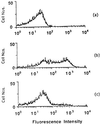P1,P4-dithio-P2,P3-monochloromethylene diadenosine 5',5'''-P1,P4-tetraphosphate: a novel antiplatelet agent
- PMID: 9108100
- PMCID: PMC20563
- DOI: 10.1073/pnas.94.8.4034
P1,P4-dithio-P2,P3-monochloromethylene diadenosine 5',5'''-P1,P4-tetraphosphate: a novel antiplatelet agent
Abstract
We have previously demonstrated in a series of searches for antithrombotic agents that diadenosine 5',5"'-P1,P4-tetraphosphate (AppppA) and its analogues are competitive inhibitors of ADP-induced platelet aggregation. Among various analogues, the P2,P3-monochloromethylene analog of AppppA (AppCHClppA) is superior to unmodified AppppA in its antiplatelet and antithrombotic effects. In this communication, we compare the antiplatelet potency of five newly synthesized agents with that of AppCHClppA. The five new agents include four diadenosine polyphosphate analogues [Ap(s)pCHClpp(s)A (p(s) indicates a thiophosphate), dAppCHClppdA, dAp,pCHClpp(s)dA, and AppCHClpCHClppA], and an adenosine tetraphosphate analogue (AppCHClpCHClp). When tested for their inhibitory effects on platelet aggregation by ADP, the most promising agent among them was Ap(s)pCHClpp(s)A. Both molecular and functional integrity of this compound proved to be stable in blood at 37 degrees C for at least 3 h. It also showed an excellent heat stability. This agent inhibits a number of aspects of ADP-induced platelet activation-e.g., release reaction, cytoplasmic calcium mobilization, thromboxane production, fibrinogen binding sites, and platelet factor 3 activity. Moreover, platelet aggregation induced by agonists other than ADP-e.g., arachidonic acid, collagen, and epinephrine-was inhibited partially by Ap(s)pCHClpp(s)A. It is concluded that (i) Ap(s)pCHClpp(s)A is a promising antiplatelet agent; (ii) it is resistant to blood phosphodiesterases and stable to heat treatment; (iii) platelet aggregation induced by collagen, epinephrine, or arachidonic acid is also inhibited in part by this agent; and (iv) specificity of the inhibitory effects is presented by unmodified adenosine moieties of the agent. Resistance to phosphodiesterases raises the possibility of oral administration.
Figures



Similar articles
-
Antiplatelet activity, P2Y₁ and P2Y₁₂ inhibition, and metabolism in plasma of stereoisomers of diadenosine 5',5'″-P¹ ,P⁴-dithio-P²,P³-chloromethylenetetraphosphate.PLoS One. 2014 Apr 10;9(4):e94780. doi: 10.1371/journal.pone.0094780. eCollection 2014. PLoS One. 2014. PMID: 24722456 Free PMC article.
-
Antithrombotic effect of beta,beta'-monochloromethylene diadenosine 5',5"'-P1,P4-tetraphosphate.Proc Natl Acad Sci U S A. 1992 Nov 15;89(22):11056-8. doi: 10.1073/pnas.89.22.11056. Proc Natl Acad Sci U S A. 1992. PMID: 1438314 Free PMC article.
-
Analogues of diadenosine 5',5'''-P1,P4-tetraphosphate (Ap4A) as potential anti-platelet-aggregation agents.Proc Natl Acad Sci U S A. 1992 Mar 15;89(6):2370-3. doi: 10.1073/pnas.89.6.2370. Proc Natl Acad Sci U S A. 1992. PMID: 1549600 Free PMC article.
-
The platelet P2 receptors as molecular targets for old and new antiplatelet drugs.Pharmacol Ther. 2005 Nov;108(2):180-92. doi: 10.1016/j.pharmthera.2005.03.009. Epub 2005 Jun 13. Pharmacol Ther. 2005. PMID: 15955565 Review.
-
Adenosine diphosphate receptors on blood platelets: potential new targets for antiplatelet therapy.Acta Biochim Pol. 2005;52(2):411-5. Epub 2005 May 15. Acta Biochim Pol. 2005. PMID: 15912207 Review.
Cited by
-
New highly active antiplatelet agents with dual specificity for platelet P2Y1 and P2Y12 adenosine diphosphate receptors.Eur J Med Chem. 2016 Jan 1;107:204-18. doi: 10.1016/j.ejmech.2015.10.055. Epub 2015 Nov 9. Eur J Med Chem. 2016. PMID: 26588064 Free PMC article.
-
Two hydrolase resistant analogues of diadenosine 5',5"'-P1,P3-triphosphate for studies with Fhit, the human fragile histidine triad protein.Nucleosides Nucleotides. 1998 Jan-Mar;17(1-3):301-8. doi: 10.1080/07328319808005178. Nucleosides Nucleotides. 1998. PMID: 9708352 Free PMC article.
-
Antiplatelet activity, P2Y₁ and P2Y₁₂ inhibition, and metabolism in plasma of stereoisomers of diadenosine 5',5'″-P¹ ,P⁴-dithio-P²,P³-chloromethylenetetraphosphate.PLoS One. 2014 Apr 10;9(4):e94780. doi: 10.1371/journal.pone.0094780. eCollection 2014. PLoS One. 2014. PMID: 24722456 Free PMC article.
-
The 2-5A system: modulation of viral and cellular processes through acceleration of RNA degradation.Pharmacol Ther. 1998 May;78(2):55-113. doi: 10.1016/s0163-7258(97)00167-8. Pharmacol Ther. 1998. PMID: 9623881 Free PMC article. Review.
-
Modified diadenosine tetraphosphates with dual specificity for P2Y1 and P2Y12 are potent antagonists of ADP-induced platelet activation.J Thromb Haemost. 2012 Dec;10(12):2573-80. doi: 10.1111/jth.12035. J Thromb Haemost. 2012. PMID: 23083103 Free PMC article.
References
-
- Hass W K, Easton D, Adams H P. N Engl J Med. 1989;321:501–507. - PubMed
-
- Weber M A J, Hasford J, Taillens C, Zitzmann A, Hahalis G, Seggewiss H, Langbehn A F, Fassbender D, Buchwalsky R, Theisen K, Hauf E. Am J Cardiol. 1990;66:1461–1468. - PubMed
-
- Lekstrom J A, Bell W R. Medicine. 1991;70:161–177. - PubMed
-
- Bernat A, Mares A M, Defreyn G, Maffrand J P, Herbert J M. Thromb Haemostasis. 1993;70:812–816. - PubMed
-
- Maffrand J P, Bernat A, Delebassée D, Defreyn G, Cazenave J P, Gordon J L. Thromb Haemostasis. 1988;59:225–230. - PubMed
Publication types
MeSH terms
Substances
Grants and funding
LinkOut - more resources
Full Text Sources
Other Literature Sources
Medical
Miscellaneous

